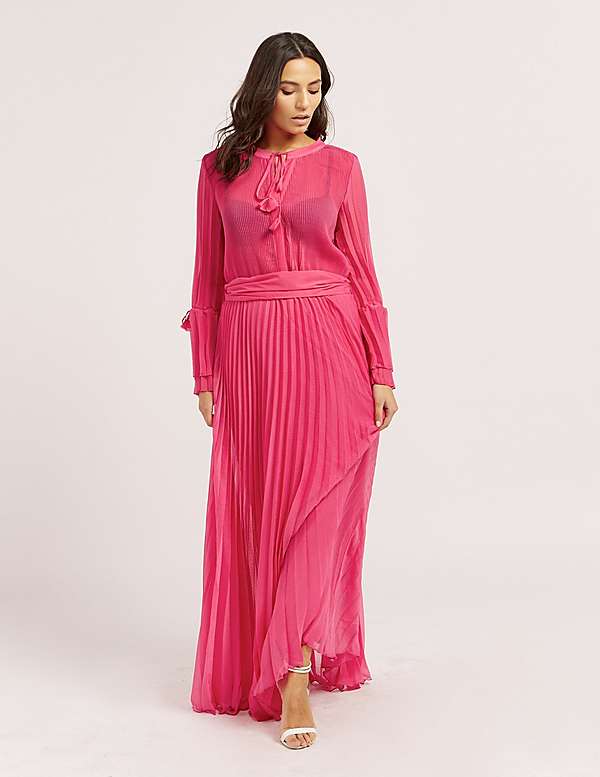The pleated maxi dress is a style that has been in the limelight for a long time. It had been trending a couple of years back but it is finding its way back to the fashion world. Pleats designs are a vintage style that was mostly in heavy materials like plaid, cotton and even polyester. Pleated Maxi skirts are so comfortable you will literally feel like you are floating on clouds. They drape so easily on your skin that you will feel like you are dressed in the finest of silk. The best part is that pleated maxi skirts come in various brightly coloured styles and designs that you can choose from. They are best worn for functions like weddings, family celebrations like graduation and even going out wit friends and family. The pleated maxi dresses can be paired with wedge shoes, strappy heels or sandals and even flats depending on where you are going. Pleated maxi skirts also come in various designs, from low back pleated maxi dress, v-neck pleated maxi dress, strappy pleated maxi dress to prints pleated maxi dresses. Here are a few types of pleats that you need to know.
Accordion Accordion pleats or knife pleats are a form of tight pleating which allows the garment to expand its shape when moving. Accordion pleating is also used for some dress sleeves, such as pleating the end of the elbow, with the fullness of the pleat gathered closely at the cuff. This form of pleating inspired the "skirt dancing" of Loie Fuller. Accordion pleats may also be used in hand fans.
Box pleats
Box pleats are knife pleats back-to-back, and have a
tendency to spring out from the waistline. They have the same 3:1 ratio as
knife pleats, and may also be stacked to form "stacked-" or
"double-box pleats". These stacked box pleats create more fullness
and have a 5:1 ratio. They also create a bulkier seam. Inverted box pleats have
the "box" on the inside rather than the outside.
Cartridge pleats
Cartridge pleats are used to gather a large amount of fabric
into a small waistband or armscye without adding bulk to the seam. This type of
pleating also allows the fabric of the skirt or sleeve to spring out from the
seam. During the 15th and 16th centuries, this form of pleating was popular in
the garments of men and women. Fabric is evenly gathered using two or more
lengths of basting stitches, and the top of each pleat is whipstitched onto the
waistband or armscye. Cartridge pleating was resurrected in 1840s fashion to
attach the increasingly full bell-shaped skirts to the fashionable narrow
waist.
Fluted
Fluted pleats or "flutings" are very small,
rounded or pressed pleats used as trimmings. The name comes from their
resemblance to a pan flute.
Fortuny
Fortuny pleats are crisp pleats set in silk fabrics by
designer Mariano Fortuny in the early 20th century, using a secret
pleat-setting process which is still not understood.
Honeycomb
Honeycomb pleats are narrow, rolled pleats used as a
foundation for smocking.
Kick
Kick pleats are short pleats leading upwards from the bottom
hem of garments such as skirts or coats, usually at the back. They allow the
garment to drape straight down when stationary while also allowing freedom of
movement.
Organ
Organ pleats are parallel rows of softly rounded pleats
resembling the pipes of a pipe organ. Carl Köhler suggests that these are made
by inserting one or more gores into a panel of fabric.
Plissé
Plissé pleats are narrow pleats set by gathering fabric with
stitches, wetting the fabric, and "setting" the pleats by allowing
the wet fabric to dry under weight or tension. Linen chemises or smocks pleated
with this technique have been found in the 10th century Viking graves in Birka.
Rolled
Rolled pleats create tubular pleats which run the length of
the fabric from top to bottom. A piece of the fabric to be pleated is pinched
and then rolled until it is flat against the rest of the fabric, forming a
tube. A variation on the rolled pleat is the stacked pleat, which is rolled
similarly and requires at least five inches of fabric per finished pleat. Both
types of pleating create a bulky seam.
Watteau
Watteau pleats are one or two box pleats found at the back
neckline of 18th century sack-back gowns and some late 19th century tea gowns
in imitation of these. The term is not contemporary, but is used by costume
historians in reference to these styles as portrayed in the paintings of
Antoine Watteau.
Kingussie pleats
Kingussie pleats, named after the town in Scotland, are a
very rarely seen type of pleat used in some Scottish kilts. They consist of a
single centrally located box pleat in the rear of the kilt with knife pleats
fanning out on either side.

















Post a Comment